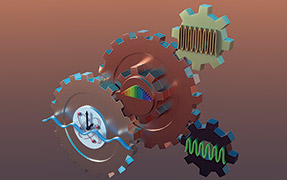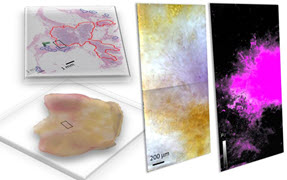Strong IR laser fields for measuring the band structure of solids
The energy of electrons in crystalline solids is what determines certain properties of materials (e.g., conductivity and transparency). The electron energies also encode the ‘many-body’ interactions that control exotic phases of matter (such as superconductivity). Measuring electron energies in solids—the ‘band structure’—is therefore greatly desired. Such measurements, however, are no mean feat, particularly for electrons that have a large momentum.
The typical tool that is currently used to measure band structures of solid materials is angle-resolved photoemission spectroscopy (ARPES).1 In this technique (depicted on the left of Figure 1), photons with enough energy to eject electrons from a material are fired at a sample. The energy and momentum of the emitted electrons are then measured. From the measured energy and momentum information, the structure of the band, from which the electrons were emitted, can be revealed. To date, ARPES has been used extensively to measure a wide range of materials (including semiconductors and superconductors).2, 3 Although it provides a direct measurement of band structures, the technique also has some limitations. For instance, the sample and the measurement apparatus must be kept under high vacuum conditions (because the emitted electrons are otherwise scattered and absorbed by air). This limits the possibility of studying surface chemistry at ambient conditions (e.g., by catalysis) or enclosed samples (such as those contained in diamond anvils for high-pressure physics experiments). Furthermore, with ARPES, only a very thin layer of material beneath the surface can typically be probed (because slow electrons cannot escape from deeper in the bulk material).
In ARPES experiments, weak laser beams of highly energetic UV or x-ray photons are typically used. To complement and improve the ARPES approach, we have therefore developed a new technique (illustrated on the right of Figure 1) that involves firing intense beams of low-energy IR photons at a semiconductor sample. In this way, we can generate new photons at energies that are integer multiples of the initial, incoming photons. This is known as generating ‘high harmonics.’4

In our method, the laser electric field has strength comparable to the field that binds electrons to the ions. This strong optical field causes an electron to almost instantaneously tunnel from the top of the valence band to the bottom of the conduction band (in direct band gap materials), thereby creating a hole in the valence band. This step is labeled 1 in Figure 1. In the next step—labeled 2 in Figure 1—the electron and the hole are accelerated to high momentum and travel in opposite directions in real space. When the optical field changes sign, the electron and the hole accelerate back toward each other and collide with a non-zero momentum. At this point (3 in Figure 1), the electron and hole recombine. This causes the emission of a photon that can escape the material and be detected. The energy of this photon equals the difference in energy between the conduction and valence bands at the moment of collision.
There is a unique connection between the momentum at collision and the trajectory of the electron and the hole. Knowledge of the trajectory is therefore sufficient for linking the momentum of the electron-hole pair to the emitted photon energy. This link determines the momentum-dependent band gap between the conduction and valence bands. To tag electron/hole trajectories to their associated emitted photon energy, we add and synchronize a much dimmer laser field (at twice the optical frequency of the strong field).5 This added field perturbs the electron and hole trajectories and induces a clear spectral signature. This signature is specific to each trajectory and can therefore be used to uniquely identify it.
We believe that our technique will be particularly useful for studying materials in a number of novel situations, e.g., materials enclosed in highly pressurized diamond anvil cells because the diamond is transparent to the incident and emitted light. Materials in very high magnetic fields, which tend to deflect electrons in ARPES, can also be studied with our approach. Lastly, our method can be used to probe the bulk composition of a material, because the emitted light can escape the solid better than electrons in the ARPES technique. Furthermore, our electron-hole recombination process lasts only about half an optical cycle (a few femtoseconds). This means that our technique can also be used to study changes in band structure that occur over very short timescales,6 e.g., the onset of screening or the dynamics of laser-induced material modifications.
In summary, we have developed a new method to study the band structure of solid materials. In our approach, we fire an intense beam of low-energy IR photons at the target sample. Our work combines recent advances in laser technology (which enable strong, but non-destructive interactions of laser light with solids) with the techniques of ‘attosecond science’ that allow the control of electronic motion, with sub-laser-cycle temporal precision. In our future work, we will look at dynamical changes in the band structure that follow carrier excitation and laser-induced damage.
Giulio Vampa received his PhD in physics from the University of Ottawa, under the supervision of Paul Corkum. He is currently a postdoctoral fellow, whose research interest is strong field interactions with condensed matter.



